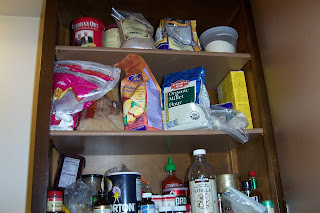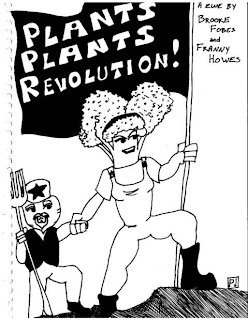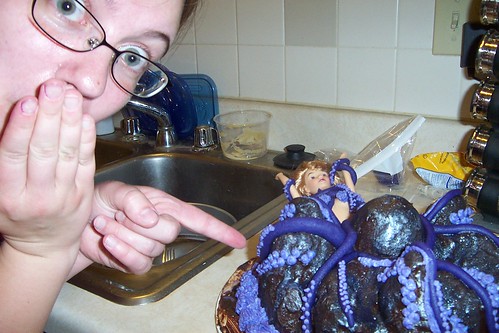Friday, November 9, 2007
Monday, November 5, 2007
Cooking with a million different kinds of flour
If you are gluten-free and you like to bake and you have some way of bankrolling your habit, you and I are likely to have very many kinds of flour in our kitchens. I came up with a convenient way of keeping the oddball flours and loose grains I use most frequently neatly (more or less) organized. I have a batallion of plastic take-out containers (the kind a large order of hot and sour soup comes in?) dedicated to my cause. My health food stores all offer them, usually to hold wet bulk ingredients.
I came up with a convenient way of keeping the oddball flours and loose grains I use most frequently neatly (more or less) organized. I have a batallion of plastic take-out containers (the kind a large order of hot and sour soup comes in?) dedicated to my cause. My health food stores all offer them, usually to hold wet bulk ingredients.
All mine are sharpie-labeled for what goes in them, and then organized in these neat pull-out trays that my new apartment has in the kitchen. Before, I had a shelf of one of my auxiliary food holding bookshelves dedicated to them. The system works really well!
That said, there is still a huge amount of overflow. I am five feet tall, so high cupboard shelves are for things I don't use very often, and the overflow bags from my flours. (The bottom cupboard shelf is easy to reach, and holds my loose spices and odd stuff. I have a mammoth spice rack from Costco that was a Christmas present from my mom that lurks off-camera.) Behold:
And then I have a drawer dedicated to bags of things that I don't have enough of to justify a whole canister, mostly nuts and chocolate chips:
I've seen frequent recommendations for gluten-free people to find your favorite GF flour mix and use it for everything. I don't agree with this, mostly because I am anal about my flours nuances and tastes matching my desired outcome. I use a different blend for almost anything. For baking, you really need a starchy flour plus a bulky flour, so I usually do rice + bulky/nutritious flour (ie. quinoa)+ tapioca/potato/both. For breading things to be fried I really like bean/chickpea based flours. I've never actually worked with straight besan flour but I really like the Bob's Red Mill blend for making fried tofu. It gets a really nice golden crust. (It's too expensive for me to bake with it often though.) And for cornbread (I will post the recipe later in the month!) I use a mix of corn flour, brown rice flour, and buckwheat.
Yay for random powdered substances taking over my kitchen!
Sunday, November 4, 2007
VeganMoFo, post the second
 This post is about cupcakes.
This post is about cupcakes.I believe in experimentation when it comes to food. You should try things! I love trying things! Sometimes it works out spectacularly: I made an amazing variant of the almond Vanilla Gluten Freedom cupcakes from Vegan Cupcakes Take Over the World. From reputation alone, the owner of a local bakery here actually wants to talk to me about the recipe. Which is exciting!
However. Sometimes experimenting blows up. But you have to keep going! For SCIENCE!
Is it wrong that the part of me that's wishy-washy about going to grad school is the same part of me that really wants to become the food allergy Alton Brown? I guess that's the food hacker in me. I don't know of anyone else doing the VeganMoFo challenge who does it FOR SCIENCE. Seriously, though, gluten-free baking is mad science if I've ever done it. I have a good friend who is a food scientist; he took a whole class on cereals and the basic point was: gluten traps air, makes things good. So, he was sufficiently impressed that I could bake without it, as well as the fact that I can cook with agar, which he and his housemates mainly recognized as a laboratory preparation.
 So. Chocolate millet macadamia cupcakes. Chocovic cocoa powder. Macadamia nut oil. The nutty deliciousness and tenderness of millet flour. They were supposed to be such a brilliant achievement and I was so convinced they would work, I tried to make them twice even after the first batch foamed up out over the tops of my cupcake pans and made a mess of my oven. I was sure that I could substitute millet flour for the quinoa flour in the Chocolate Gluten Freedom cupcakes. The first time I convinced myself I had mismeasured the leavening. But it wasn't that. I took pictures of one of the batches because they looked so weird to me.
So. Chocolate millet macadamia cupcakes. Chocovic cocoa powder. Macadamia nut oil. The nutty deliciousness and tenderness of millet flour. They were supposed to be such a brilliant achievement and I was so convinced they would work, I tried to make them twice even after the first batch foamed up out over the tops of my cupcake pans and made a mess of my oven. I was sure that I could substitute millet flour for the quinoa flour in the Chocolate Gluten Freedom cupcakes. The first time I convinced myself I had mismeasured the leavening. But it wasn't that. I took pictures of one of the batches because they looked so weird to me.Who knows exactly what went wrong. I'm pissed I used up my nice cocoa powder that I only bought a little baggie of cause it was freaking expensive, but other than that, I'm unharmed. I will continue to bake. For science! And also, for me, because cupcakes are damn tasty.
Friday, November 2, 2007
VeganMoFo

So. The time has arrived to start this food blog in earnest. The time is now. The time is VeganMoFo!
VeganMoFo stands for the Vegan Month of Food. It is a foodie version of NaNoWriMo, the national novel writing month challenge. The challenge this month, as reported here, is to publish one entry related to vegan food every day for the whole month. I am a bit late as I found out about this today but I will try my hardest to catch up!
Today I will write about my recent food laziness. I have been eating a ton of frozen food the past couple of weeks. I have actually made myself sick of my favorite frozen pizza, the Amy's Organics gluten-free soy cheese spinach one. My last frozen waffles are in the toaster right now.
I suppose I have been tired and anxious and stressed out lately so much that my usual delight in preparing interesting dinners (sadly for one, the worst part of living alone is not having anyone to cook for) has flagged. But today I felt like cooking, and realized the only thing I really had around to make for breakfast was a bag of hash browns. This will not do. So, I took my trusty 15% off coupon to Better Health and stocked up to cook up a storm in November!
However I have to wean myself back into real cooking (and baking; I'm a bit gun-shy from my Chocolate Millet Macadamia cupcake disaster which I really ought to document here...) so this is what I'm making for dinner:
Cheaty, Non-Cuisine, Super-Easy Vegan Nachos (for gluties)
-corn chips
-vegan refried beans in a can
-sliced olives
-salsa verde
-tofutti sour cream
You heat the beans, you put them on the chips (or in a bowl and just scoop them), you add olives and salsa and use the sour cream sparingly because it'll melt all over if you put it on the hot beans. I'm a lazy bum but at least this won't explode all over my oven like those blasted cupcakes...
Wednesday, August 15, 2007
Plants Plants Revolution goes to press!

The first 20 copies of PPR are sliding off the printer as we speak, and it looks fantastic. Both Brooke and I are super excited and proud to have our names on it.
We aren't giving away copies until after our workshop, which will be Saturday at 12:00 at the Vegan Macaroni and Cheese House (419 Shepard St, in Lansing) but here is a scan of the cover, illustrated by my very significant other. I will post the .pdf file of the zine after the workshop!
Monday, August 13, 2007
Improvisational cooking
Cooking and baking from scratch are also mystifying to people who have never tried it, or even seen a bag of flour or a stockpot before. It is healthier and cheaper to use whole ingredients and not to rely on pre-made starter foods like veggie crumbles, canned sauces, and stuff-in-a-box. It is also tastier and more rewarding.
The industrial mass-production based food system was originally attractive to people because they were guaranteed the same sensory experience every time they bit into an Oreo or opened a box of Kraft Dinner. However, people have moved beyond that and now seek novelty with their food...which, in our current food system, results in an endless stream of new food "products" which are really just the same eight ingredients in different colored boxes. Fresh, fully-ripe whole foods are the original novel food, providing humans with stimulation and variety, as well as actual nutrients and a connection to the life of the plant.
We both started cooking from scratch by reading labels of our favorite prepared foods and trying to recreate them (a food hacker might call this reverse engineering which sounds way cooler than "reading the label on the soup can"). This is a good first step.
A second step is to find a combination of major elements that results in a satisfying dish--for example, a sauce with a protein in it, served over a grain, or lentil soup with random vegetables and a combination of herbs that seems tasty to you. (Brooke says: I have made medicinal soups this way--herbs like sage have healing properties, and the ever-popular garlic and onions have mild anti-viral properties as well as being ubiquitous seasoning bases. Franny made me say the word "ubiquitous".)
Other things you can do with the courage to cook without a safety net: tweak recipes to suit your tastes (as well as your allergies), combine more than one recipe for a dish from different sources to take advantage of the good qualities of both recipes, and veganize even the meatiest of loafs!
Thursday, August 9, 2007
Franny's Food Story
I was born in 1984 in the suburbs of Detroit. I have been violently lactose intolerant since I was 13 (although for a while I invented a new radical political faction called anti-lactarianism...we believe that milk is murder...I think we were absorbed into veganism though). Later on in life I started having serious gastrointestinal distress and found out that I have irritable bowel syndrome and am sensitive to MSG and gluten (although my celiac disease test came back negative). I’m also allergic to mangoes.
I believe in the hacker ethic when it comes to food and cooking—this can be hard to explain and has freaked out acquaintances before as they seem to fear that a food hacker would be the kind of person to clone a cow, fill it with nanobots, and then serve it to them cold-seared with aspirin sauce. That is not my deal. I just believe in the radical idea that food should help people.
I was inspired by the work of Richard Stallman, the famous software freedom activist and hacker, to codify my beliefs about food:
The Four Freedoms of Food¹
Freedom 0: to eat the food or to not eat the food.
Freedom 1: to know the detailed origin of the food.
Freedom 2: to grow the food and distribute the food to help your neighbor.
Freedom 3: to cook the food and modify the food and recipe as you see fit, and to redistribute your recipes and methods to the public for the benefit of the community, as long as doing so doesn’t violate freedoms 0, 1, or 2.
Taking inspiration from the Free Software Movement, I believe in free food: free as in free speech, not necessarily as in free beer. In addition to the freedom to grow and eat food, I also believe that people should have freedom from food that they are allergic or sensitive to, or that they are ethically opposed to consuming. That is, your freedom to grow or eat food ends where you put undisclosed allergens in your manufactured food or fish genes into my supposedly vegan tomato.
¹These are based on the Four Freedoms of Code: 0—The freedom to run the code, for any purpose; 1—the freedom to study how the program works, and adapt it to your needs; 2—the freedom to redistribute copies so you can help your neighbor, and 3—the freedom to improve the program and release it to the public so that the whole community benefits. See Chapter 3, Free Software Definition, in the collected works of Richard M. Stallman, available online for free:
http://www.gnu.org/philosophy/fsfs/rms-essays.pdf
